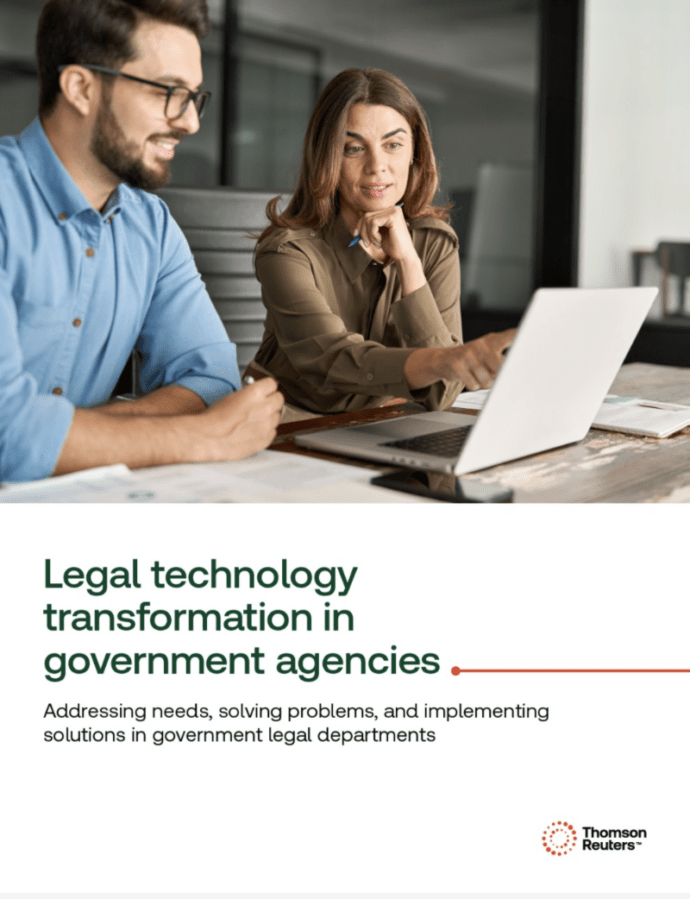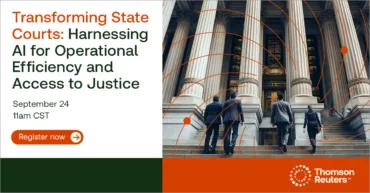Next-generation tech enables efficient, non-duplicative legal workflow
If you’re like most government legal professionals, you’re satisfied with your job and the tools you have to do it. But it could be better: A Thomson Reuters State of the Government Legal Department Report says that while their satisfaction is strong, over half of the respondents believe they spend too much time on admin tasks. Nearly half of them feel that those tasks diminish their time spent on their legal practice.
The angst these lawyers feel is fundamentally about efficiency — a seeming deficit in government legal offices. That’s coupled with a desire for improved efficiency from their “clients,” users of government legal services. As in many industries, when it comes to efficiency, technology is ready to help.
The four use cases below demonstrate how you can become better and faster at mainstream legal tasks.
Jump to ↓

CoCounsel
Bringing together generative AI, trusted content and expert insights
Meet your AI assistant ↗Intake and matter management
It’s happened before: you get an email from a citizen inquiring about a matter. You may not be the right lawyer to deal with it, or the person has contacted multiple people hoping to find a fast answer. So, even before you begin, the matter is not on an efficient trajectory. With inquiries coming via email, phone, or in person, requests could end up in multiple inboxes, leading to duplicate efforts and difficulty tracking the matter’s status.
When you’re overwhelmed with a number of requests, the intake and triage process demands efficiency through standardization and automation. The makeshift nature of taking requests by a variety of methods results in inconsistent information and ad-hoc delegation. By using electronic forms and auto-routing for all requests, government lawyers get complete information and know what’s been assigned to them. This ensures that intake becomes more focused — the right form, the right information, and the right lawyer. Requesters don’t proceed until all pertinent information is submitted, but when it is, their matter moves faster. And, by tracking all matters electronically, department heads can maintain reasonable workloads for their lawyers, have visibility to deadlines, and review analytics for future insights.
Contract lifecycle management
Contracts play a vital role in the functioning of a developed society. As a lawyer, you’ve probably been involved with dozens or hundreds of them. But even with extensive contract experience, you can get bogged down with process inefficiencies. Multiple parties mean multiple edits and revisions. Repurposing the same contracts for different matters can introduce human errors and missed deadlines. A process that should be straightforward can get off track quickly.
Here’s where next-generation technology shines. A centralized, digital repository for legal documents can:
- House contracts and other documents, classifying them by matter type, constituent, deadlines, or assigned lawyer
- Provide timelines and at-a-glance status
- Leverage artificial intelligence (AI) to extract contract insights, locate and correct inconsistencies in contract creation, and reduce lawyer time on repetitive tasks
- Utilize generative AI to create a starting point for contract writing
- Assign customized levels of security so lawyers can share sensitive documents in confidence
Public records requests
Transparency in government is fundamental to public trust and active participation by citizens. Federal laws, like the Freedom of Information Act (FOIA) for example, ensure the right to view and obtain copies of documents held by government departments (with certain sensitive-information exceptions.)
Poorly structured systems and workflows can hinder the speedy fulfillment of these requests, leading to delays and backlogs. Even clear-cut requests can strain inefficient systems, eroding public confidence and increasing the risk of lawsuits.
A central repository, powered by AI, can automate data sorting, relevance prediction, and document redaction. Searches become more logical, even without detailed search terms. With billions of government agency records, what could take weeks in a manual search can be done in minutes or hours. AI can also generate automated performance metrics, providing managers with an accurate picture of the volume of requests received and their department’s response record.
Title IX incident reporting
Title IX, the landmark law implemented in 1972, prohibits discrimination based on sex in any federally funded education program or activity. Its protections cover students, faculty, and staff.
Handling Title IX incidents is often sensitive work, potentially involving underage students in delicate situations. Timing is also critical, as when a student is reporting the behavior of a current instructor. If incidents are mismanaged, the implications can be acute for both the institution and the filer.
Title IX workflows can be simplified with advanced technology. With a workflow tool, you can quickly check if a school is in compliance based on the current judicial interpretation.
An advanced Title IX workflow platform can also simplify the job for government lawyers. It helps you quickly check if an educational institution complies with Title IX using the latest interpretations of the statute. Plus, the tool can automate sorting and prioritization of requests to improve accuracy and response time.
For those filing a Title IX incident, the process is now more streamlined with automated intake. Easy-to-fill electronic forms detail the violation, including important details like dates and locations. Plus, all communications between you and your clients are fully secure and accessible only to relevant parties. This ensures clients can be specific about the violation with complete confidence.
Embracing the right technology choice
As a government lawyer, you’ve dedicated yourself to serving the public. Advanced technology can empower you to be more efficient, more timely, and ultimately happier about your work. Download our latest white paper below to learn more about how legal AI tools can help you re-imagine your workflow.














